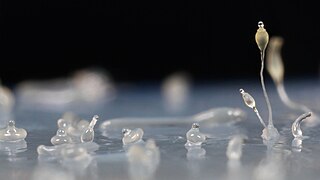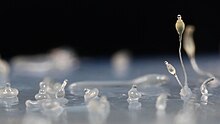
A pseudopod or pseudopodium is a temporary arm-like projection of a eukaryotic cell membrane that is emerged in the direction of movement. Filled with cytoplasm, pseudopodia primarily consist of actin filaments and may also contain microtubules and intermediate filaments. Pseudopods are used for motility and ingestion. They are often found in amoebas.

Excavata is an extensive and diverse but paraphyletic group of unicellular Eukaryota. The group was first suggested by Simpson and Patterson in 1999 and the name latinized and assigned a rank by Thomas Cavalier-Smith in 2002. It contains a variety of free-living and symbiotic protists, and includes some important parasites of humans such as Giardia and Trichomonas. Excavates were formerly considered to be included in the now obsolete Protista kingdom. They were distinguished from other lineages based on electron-microscopic information about how the cells are arranged. They are considered to be a basal flagellate lineage.

Amoebozoa is a major taxonomic group containing about 2,400 described species of amoeboid protists, often possessing blunt, fingerlike, lobose pseudopods and tubular mitochondrial cristae. In traditional classification schemes, Amoebozoa is usually ranked as a phylum within either the kingdom Protista or the kingdom Protozoa. In the classification favored by the International Society of Protistologists, it is retained as an unranked "supergroup" within Eukaryota. Molecular genetic analysis supports Amoebozoa as a monophyletic clade. Modern studies of eukaryotic phylogenetic trees identify it as the sister group to Opisthokonta, another major clade which contains both fungi and animals as well as several other clades comprising some 300 species of unicellular eukaryotes. Amoebozoa and Opisthokonta are sometimes grouped together in a high-level taxon, variously named Unikonta, Amorphea or Opimoda.

The opisthokonts are a broad group of eukaryotes, including both the animal and fungus kingdoms. The opisthokonts, previously called the "Fungi/Metazoa group", are generally recognized as a clade. Opisthokonts together with Apusomonadida and Breviata comprise the larger clade Obazoa.
In Biology, Archezoa is a term that has been introduced by several authors to refer to a group of organisms. Authors include Josef Anton Maximilian Perty, Ernst Haeckel and in the 20th century by Thomas Cavalier-Smith (1942–2021) in his classification system. Each author used the name to refer to different arrays of organisms. This reuse by later authors of the same taxon name for different groups of organisms is widely criticized in taxonomy because the inclusion of the name in a sentence does not make sense unless the particular usage is specified. All uses of 'Archezoa' are now obsolete.

Naegleria is a free living amoebae protist genus consisting of 47 described species often found in warm aquatic environments as well as soil habitats worldwide. It has three life cycle forms: the amoeboid stage, the cyst stage, and the flagellated stage, and has been routinely studied for its ease in change from amoeboid to flagellated stages. The Naegleria genera became famous when Naegleria fowleri, a human pathogenic strain and the causative agent of primary amoebic meningoencephalitis (PAM), was discovered in 1965. Most species in the genus, however, are nonpathogenic, meaning they do not cause disease.

The Rhizaria are a diverse and species-rich supergroup of mostly unicellular eukaryotes. Except for the Chlorarachniophytes and three species in the genus Paulinella in the phylum Cercozoa, they are all non-photosynthethic, but many foraminifera and radiolaria have a symbiotic relationship with unicellular algae. A multicellular form, Guttulinopsis vulgaris, a cellular slime mold, has been described. This group was used by Cavalier-Smith in 2002, although the term "Rhizaria" had been long used for clades within the currently recognized taxon. Being described mainly from rDNA sequences, they vary considerably in form, having no clear morphological distinctive characters (synapomorphies), but for the most part they are amoeboids with filose, reticulose, or microtubule-supported pseudopods. In the absence of an apomorphy, the group is ill-defined, and its composition has been very fluid. Some Rhizaria possess mineral exoskeletons, which are in different clades within Rhizaria made out of opal, celestite, or calcite. Certain species can attain sizes of more than a centimeter with some species being able to form cylindrical colonies approximately 1 cm in diameter and greater than 1 m in length. They feed by capturing and engulfing prey with the extensions of their pseudopodia; forms that are symbiotic with unicellular algae contribute significantly to the total primary production of the ocean.

The metamonads are a large group of flagellate amitochondriate microscopic eukaryotes. Their composition is not entirely settled, but they include the retortamonads, diplomonads, and possibly the parabasalids and oxymonads as well. These four groups are all anaerobic, occurring mostly as symbiotes or parasites of animals, as is the case with Giardia lamblia which causes diarrhea in mammals.

Pelomyxa is a genus of giant flagellar amoebae, usually 500–800 μm but occasionally up to 5 mm in length, found in anaerobic or microaerobic bottom sediments of stagnant freshwater ponds or slow-moving streams.

Lobosa is a taxonomic group of amoebae in the phylum Amoebozoa. Most lobosans possess broad, bluntly rounded pseudopods, although one genus in the group, the recently discovered Sapocribrum, has slender and threadlike (filose) pseudopodia. In current classification schemes, Lobosa is a subphylum, composed mainly of amoebae that have lobose pseudopods but lack cilia or flagella.

Amorphea is a taxonomic supergroup that includes the basal Amoebozoa and Obazoa. That latter contains the Opisthokonta, which includes the Fungi, Animals and the Choanomonada, or Choanoflagellates. The taxonomic affinities of the members of this clade were originally described and proposed by Thomas Cavalier-Smith in 2002.

The Archamoebae are a group of protists originally thought to have evolved before the acquisition of mitochondria by eukaryotes. They include genera that are internal parasites or commensals of animals. A few species are human pathogens, causing diseases such as amoebic dysentery. The other genera of archamoebae live in freshwater habitats and are unusual among amoebae in possessing flagella. Most have a single nucleus and flagellum, but the giant amoeba Pelomyxa has many of each.

Eumycetozoa, or true slime molds, is a diverse group of protists that behave as slime molds and develop fruiting bodies, either as sorocarps or as sporocarps. It is a monophyletic group or clade within the phylum Amoebozoa that contains the myxogastrids, dictyostelids and protosporangiids.

Corticata, in the classification of eukaryotes, is a clade suggested by Thomas Cavalier-Smith to encompass the eukaryote supergroups of the following two groups:

Mastigamoeba is a genus of pelobionts, and treated by some as members of the Archamoebae group of protists. Mastigamoeba are characterized as anaerobic, amitochondriate organisms that are polymorphic. Their dominant life cycle stage is as an amoeboid flagellate. Species are typically free living, though endobiotic species have been described.

Collodictyon is a genus of single-celled, omnivorous eukaryotes belonging to the collodictyonids, also known as diphylleids. Due to their mix of cellular components, Collodictyonids do not belong to any well-known kingdom-level grouping of that domain and this makes them distinctive from other families. Recent research places them in a new 'supergroup' together with rigifilids and Mantamonas, with the so-far informal name 'CRuMs'.

An amoeba, often called an amoeboid, is a type of cell or unicellular organism with the ability to alter its shape, primarily by extending and retracting pseudopods. Amoebae do not form a single taxonomic group; instead, they are found in every major lineage of eukaryotic organisms. Amoeboid cells occur not only among the protozoa, but also in fungi, algae, and animals.

Varisulca was a proposed basal Podiate taxon. It encompassed several lineages of heterotrophic protists, most notably the ancyromonads (planomonads), collodictyonids (diphylleids), rigifilids and mantamonadids. Recent evidence suggests that the latter three are closely related to each other, forming a clade called CRuMs, but that this is unlikely to be specifically related to ancyromonads
Cutosea is a small group of marine amoeboid protists proposed in 2016. It is a monotypic class of Amoebozoa containing the order Squamocutida. Cutosean organisms are characterized by a cell coat of microscales separated from the cell membrane. Three genera, Armaparvus, Sapocribrum and Squamamoeba, belong to this group, distributed in two families.

Evosea is a diverse clade of amoeboid protists discovered through molecular analyses. Along with Tubulinea and Discosea, Evosea is one of the three major groups within Amoebozoa, an important clade of eukaryotic organisms. It contains unicellular organisms that display a wide variety of life cycles and cell shapes, including amoebae, flagellates and different kinds of slime molds.




















